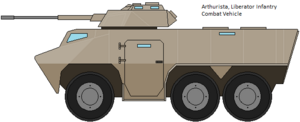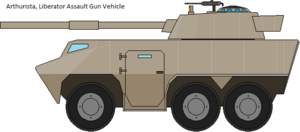FV 452 Liberator
| Liberator Modular Armoured Platform | |
|---|---|
 | |
| Place of origin | |
| Service history | |
| In service | 1978-Present |
| Used by | Arthurista |
| Production history | |
| Designed | 1975 |
| Manufacturer | Arthuristan Dynamics |
| Produced | 1977 - present |
| Specifications | |
| Weight | Basic: 16.4 tonnes. Fully loaded and up-armoured: 20.7 tonnes |
| Length | 7.32 m |
| Width | 2.5 m |
| Height | 2.24 m (hull) |
| Crew | 3 |
| Passengers | See below |
| Armor | aluminium, steel |
Main armament | Various (see below) |
| Engine | Apollo Motors TD-1 6-cylinder turbo-diesel 360bhp |
Operational range | 900km on road |
| Speed | 90 kph on road |
The FV 452 Liberator Modular Armoured Platform is a family of light armoured vehicles of Arthuristan design. It was originally conceived by Arthuristan Dynamics in the mid-70s as a cost-effective design intended primarily for export, although it rapidly acquired orders from the Commonwealth Army as a vehicle which would complement and, in time, ultimately replace the FV430 series.
The Liberator was derived from the chassis of a 6-wheeled lorry. It was conceived as a design which could serve as the primary armoured fighting vehicle for developing nations, or else serve in the armies of more developed nations where the protection and firepower of heavier and more expensive tracked infantry fighting vehicles are not strictly required.
Compared to the latter, Liberators are significantly cheaper to procure and operate, as well as simpler to maintain. Unlike tracked vehicles, Liberators do not require tank transporters for long road marches and may drive themselves to the destination. Their practical radius of action, roughly 900km, is double that of the Claymore Infantry Fighting Vehicle. Compared to the latest 8x8 armoured vehicle platforms such as the AMV or Boxer, Liberators retain the edge in preocurement costs, running costs and simplicity of maintenance, while still being adequate for most mechanised infantry combat missions.
A partial replacement of the Liberator by the FV 459 Ulysses has been ordered. As of late-2019, two out of the Commonwealth Army's five mechanised brigades have transitioned to the new vehicles. The remaining three may be re-equipped as and when budget allows.
Design
Mobility
The Liberator is powered by a 360 bhp 6-cylinder turbo-diesel engine. It propels six run-flat tyres which may are connected to a central re-inflation system. All wheels have independent coil spring suspensions, and hydraulic disc brakes. The Liberator is an amphibious vehicle - with its boat-shaped hull and pod water jet, it is capable of crossing rivers and other water obstacles on its own power.
Passive protection
The basic Liberator model is equipped with steel-reinforced aluminium/aluminium oxide armour. It is proof against rifle-calibre armour piercing rounds from all aspect, heavy machine gun rounds from the front and from airbursting 155mm artillery rounds.
The Infantry Combat Vehicle, Renaissance Vehicle, Tank Destroyer and Assault Gun variants are routinely equipped with modular applique armour. Vehicles thus reinforced possess improved resistance towards heavy machine gun fire from all aspects. Kevlar spall-liners surrounded the 'inhabited' areas, protect the crew and dismounts them against spalling-induced fragments. The installation of applique armour increases the weight of the vehicle by roughly 2 tonnes and precludes it from being buoyant enough for amphibious operation unless buoyancy aid equipment is also attached.
In addition, Liberator vehicles may be fitted with slat armour for enhanced protection against RPG, by preventing them from detonating at the distance for optimal penetration.
The bottom of the chassis is shaped like a shallow wedge. If the vehicle runs over a mine or an IED, the blast wave is deflected away from the central area of the vehicle and helping to maintain hull integrity.
Active protection
Liberators come with smoke grenades as standard. They may be fitted with the Iron Fist hard-kill active protection system following a mid-2000's upgrade, although typically it is only commonly installed on direct combat models. The system senses inbound threats via a fixed radar array, assisted by an auxiliary infra-red detector. When the incoming munition reaches the optimal range, an interceptor is launched towards it, which detonates and neutralises the projectile using focused blast energy. The hazard to infantrymen around the vehicle is reduced by the fact that the interceptor is composed of combustible materiel which does not create shrapnel.
Liberators come as standard with a halon-based automatic fire suppression system, as well as self-sealing fuel tanks. Air conditioning and a CRBN over-pressure system are standard in Arthuristan models but come as optional extras for export.
Communications
Liberators are equipped with a Bowman-based communications system, capable of providing secure integrated voice and data communications to units in the field. It also provides situational awareness and navigation assistance for vehicle commanders through the use of satellite navigation links.
Combat variants
Unless specified elsewhere, all vehicles are armed with a pintle-mounted medium machine gun.
Infantry Combat Vehicle
The Liberator ICV is operated by a crew of three (commander, driver and gunner) and is designed to transport a squad of up to eight dismounts, and provide covering fire. It is equipped with a two-man turret armed with an Antigel AD25 25x137mm autocannon and a co-axial L6V or similar medium machine gun. The main gun is fed with duel-feed arrangement, allowing the gunner to rapidly switch between KE and HE ammunition types. A laser rangefinder comes as standard, while a thermal imaging system is an optional extra for export customers. Usually, another machine gun is mounted on a second pintle mount at the rear of the vehicle.
The ICV's dismounts may enter and disembark using three doors - one on each side of the vehicle, plus a rear entrance. They may also avail themselves of the top hatches located on the roof of the rear cabin in order to provide overwatch over the rear quarter of the vehicle, or use them for ingress and egress in an emergency.
As originally configured in the 1980's, the commander's hatch atop the turret supports a pintle mount, for either a machine gun, or more often a firing unit for a Vanguard missile. The missile may be launched by the commander, but it must be reloaded by hand. In the alternative, the missile may be detached for use by the vehicle's squad of dismounts. Missiles of similar weight and dimensions, such as the MILAN or Template:WP, may also be accommodated. As of the 2010's, the pintle mounts have been mostly supplanted by the Sharpshooter Remote Weapon System among active units.
Assault Pioneer Vehicle
The APV is intended for forward light engineering tasks. Essentially identical to the ICV, it is equipped with a lightweight mine clearing dozer blade, as well as carry a small squad of field engineers.
Armoured Cavalry Vehicle
The Liberator ACV is nearly identical to the ICV, except that FLIR comes as de rigueur. It is also equipped with a mounting bracket for a lightweight folding arm, topped with a reconnaissance package including an imaging infra-red camera and laser rangefinder, allowing it to peer over cover whilst remaining hidden. Space is provided in the back for a scout team of up to four dismounts.
Tank Destroyer Vehicle
The Liberator TDV is equipped with a trainable launcher for anti-tank missiles. The launcher features two launch slot. Upon firing, the missile will be launched forward and its protective casing would be ejected out a port to the rear of each slot. The launcher is connected to a simple autoloader below, which holds three further pairs of missiles in its magazine. Sixteen additional missiles are stored in the vehicle's cabin and may be fed into the magazine when needed. The launcher is trainable across 360 degrees, although it must face forward in order to reload. As a backup measure in the event of power failure, the loader may be hand-cranked by a lever.
The TDV is crewed by a vehicle commander, a gunner, a driver and a weapons system assistant, who is responsible for loading the magazine and unblocking autoloader stoppages where necessary. Its fire control system consists of a commander's panoramic sight and a gunner's sight, both of which are fitted with thermal imaging equipment.
The default missiles of the TDV in Commonwealth Army service were the Swingfire and later the BGM-71 TOW. Export variants armed with weapons such as the HOT or Sprandel have also been proposed or marketed. TDV in Arthuristan service have been upgraded to utilise the Vidette missile.
As of the mid-2010's, the Liberator TDV has been phased out of Commonwealth Army service in favour of the Battleaxe Missile Carrier Vehicle.
Advanced Tank Destroyer Vehicle
The ATDV is equipped with a 4x4 vertical launch pod for Vantage non-line of sight precision-attack weapon, enabling it to interdict moving targets at up to 60+ km. Due to the high cost of these munitions, they are typically employed in division-level batteries in the Commonwealth Army and are procured by relatively few export customers.
Fire Support Vehicle
The FSV is a specialist vehicle for the control of artillery fire. They typically belong to artillery batteries and are attached to battalion groups to coordinate fire support. equipped with a 'Laser Locator Designator', which enables it to obtain precise range information to a lased target. Employed in combination with the vehicle's SATNAV system, it is capable of pinpointing the exact location of a designated target.
The FSV is also equipped with an enhanced communications suite, allowing it to communicate on four channels simultaneously in order to provide effective fire support to connected Fire Direction Centres.
Due to the threat they pose, FSVs are made to externally resemble ACVs in order to disguise their true function on the battlefield and, indeed, they are mostly identical in terms of sensors equipment. However, due to the enhanced C4ISR equipment which the FSV carries, there is no space for a dismounted scout team and the main gun in the turret is a dummy.
Mortar Carrier Vehicle
The basic Mortar Carrier Vehicle was, in its original configuration, armed with a L16 81mm mortar, firing through a roof hatch. This was replaced in the early-2000's with the Hatchet 120mm recoil-mortar system. It is equipped with computerised integrated navigation, self-positioning and aiming systems, which can rapidly acquire target data, then provide range, bearing and other information from fire control, allowing automatic gun-laying within a short reaction time.
Despite these advanced features, Mortar Vehicles are intended to be most cost-effective to procure than more complex turret-mortar systems. The vehicle's weapon has a burst rate of 16 rpm and a sustained fire rate of 4 rpm.
Assault Gun Vehicle
The AGV is intended to provide direct fire support to infantry units against strongpoints and field fortifications. Its default configuration is a L7 105mm rifled gun, which is capable of firing all standard 105mm ammunition such as APFSDS, HEAT, HESH and canister. Another option is the D-10 100mm rifled gun for export customers with large legacy stocks of T-54/55 ammunition. Like the Advanced Mortar Vehicle, the 100 or 105mm versions of the Assault Gun Vehicle share a chassis with the rest of the Liberator line, although it is extensively modified in order to lower the centre of gravity following the installation of a heavy turret.
Laser range finders are available by default, although thermal imaging sight is an optional extra.
Mine-layer Vehicle
The MLV is equipped with the Vulcano Scattered Mine system, enabling it it to rapidly deploy an effective minefield.
Non-combat variants
In addition to the above, the Liberator platform also possesses the following non-combat variants:
- Command vehicle
- Armoured ambulance
- Armoured recovery vehicle
- Electronic warfare vehicle
- Logistics vehicle
- UAV/UGV control station
- CRBN reconnaissance vehicle
